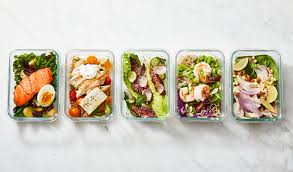Whether you’re cooking for yourself, a partner, or your whole household, meal planning can make the process easier, faster, and more affordable.

Have you ever been too exhausted at the end of the day to make dinner, but still wanted to avoid the cost of eating out? If that sounds familiar, meal planning might be the solution you’ve been looking for. It’s a valuable skill that can reduce daily stress and help you eat healthier while saving money.
Meal planning means thinking ahead about what you’ll eat and sometimes even prepping meals in advance. It can help eliminate last-minute decisions about food, support your health goals, reduce grocery bills, and more.
Below, you’ll find a beginner-friendly guide to meal planning, plus practical tips for saving money and feeding a family.
How to Start Meal Planning
Even if you think you’ve never “meal planned” before, chances are you’ve done some version of it — like deciding in the morning what’s for dinner. The difference is doing it consistently and intentionally as part of your weekly routine. Here’s how to get started:
Step 1 | Set Your Intention
Before making your first meal plan, think about your primary goal. Are you hoping to eat healthier meals? Cut down your grocery spending? Free up time during the week? Having a clear objective helps make the planning process easier and more effective.
Step 2 | Take Stock of What You Already Have
As you begin mapping out your meals, check your fridge, freezer, and pantry for ingredients you can use. Leftovers, frozen items, and pantry staples are great jumping-off points that can help minimize food waste and keep costs low.
Step 3 | Choose a Few Recipes
Once you know how many meals and which days you’re planning for, start picking recipes. If you’re planning for a short stretch, you can be a bit more adventurous. But if you’re planning for a full week or longer, stick to easy and reliable meals.
Step 4 | Write a Grocery List
With your recipes selected, put together your shopping list. Be sure to cross off anything you already have on hand. This not only saves time at the store but also helps you stay organized and avoid buying unnecessary extras.
Step 5 | Shop, Cook, and Store
Now it’s time to shop for your ingredients and, if you choose, prep your meals ahead of time. Whether you fully cook and portion out your meals or just do basic prep like chopping veggies, anything you can do ahead will make your week go more smoothly.
And that’s it — five basic steps to build your meal planning routine. But what if you’re on a tight budget or feeding a crowd? Keep reading for tips to meal plan affordably and for the whole family.
Tips for Budget-Friendly Meal Planning
Meal planning is a smart way to stretch your grocery dollars and minimize waste. Here’s how to make your meal plan as cost-effective as possible:
-
Set a realistic weekly food budget: If you’re cooking for one, $50 a week might be enough. But for a family of three or more, you’ll need to adjust accordingly. Set a budget that reflects your actual needs.
-
Build meals around sales and seasonal foods: Planning meals based on what’s on sale or in season can cut costs. Check grocery flyers or use a seasonal produce guide, like the one from the USDA, to plan your meals.
-
Go meatless sometimes: Plant-based proteins like beans, lentils, tofu, and eggs are usually more affordable than meat. Swapping them in once or twice a week can help lower your food bill.
Tips for Family Meal Planning
Getting the whole household involved in meal planning makes it more enjoyable and easier to stick to. Try these family-friendly strategies:
-
Use a shared calendar: Create a weekly or monthly meal calendar and let everyone contribute their favorite meals.
-
Pick weekly meal themes: Ideas like “Meatless Monday,” “Taco Tuesday,” or “Leftover Friday” make planning easier and give your family something to look forward to.
-
Choose customizable meals: Dishes like burrito bowls, baked potatoes, or pasta bars let everyone personalize their plate without making multiple meals.
-
Make meal planning a group effort: Assign tasks like picking recipes, writing grocery lists, shopping, or helping with cooking to different family members.
Tailor Meal Planning to Your Needs
Whether you’re meal planning to stick to a budget, improve your nutrition, lose weight, or simply eat at home more often, there are tons of resources to help you create a system that works for your lifestyle. Here are a few to check out:
-
How to Meal Prep — A Beginner’s Guide
-
How to Meal Plan: 23 Helpful Tips
-
5-Day Easy and Healthy Meal Plan
-
How to Become a Meal-Prep Master — Tips from a Nutritionist
-
How to Meal Plan for Weight Loss — A Detailed Guide
-
The 11 Best Meal Planning Apps to Help You Lose Weight
-
A 1-Week Meal Plan and Shopping List for Your Family of 4 (or More!)
-
28 Easy and Healthy Meals for Breakfast, Lunch, and Dinner
-
15 Healthy Recipes You Can Cook with Your Kids
-
17 Healthy No-Prep Recipes for the Days When You Just Can’t
-
10 Simple Dinner Ideas for Healthy Eating in Real Life
-
Healthy Dinner Recipes in 10 Minutes (or Less)
Final Thoughts
If you’re looking to reduce the time, money, and energy spent on meals each day, meal planning is a great habit to build. It doesn’t take much to get started — just a little planning and consistency. Whether you plan for a single day, an entire week, or a full month, you’ll be setting yourself up for less stress and more success in the kitchen.

These tips actually made meal prepping feel doable. Planning ahead has really reduced my weekday stress.
I’ve struggled with consistency, but following these 5 steps helped me stay on track for a whole month!
Meal planning still feels overwhelming to me. I wish the article included more examples or templates.
Solid advice. Step 3 about batch cooking is a game-changer for my busy schedule.